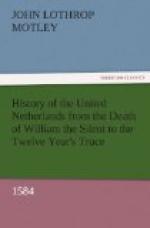Thus, by artfully inflaming the populace of Paris, and through his organized bands of confederates—that of all the large towns of France, against the Huguenots and their chief, by appeals to the religious sentiment; and at the same time by stimulating the disgust and indignation of the tax-payers everywhere at the imposts and heavy burthens which the boundless extravagance of the court engendered, Guise paved the way for the advancement of the great League which he represented. The other two political divisions were ingeniously represented as mere insolent factions, while his own was the true national and patriotic party, by which alone the ancient religion and the cherished institutions of France could be preserved.
And the great chief of this national patriotic party was not Henry of Guise, but the industrious old man who sat writing despatches in the depths of the Escorial. Spanish counsels, Spanish promises, Spanish ducats—these were the real machinery by which the plots of Guise against the peace of France and of Europe were supported. Madam League was simply Philip II. Nothing was written, officially or unofficially, to the French government by the Spanish court that was not at the same time communicated to “Mucio”—as the Duke of Guise was denominated in the secret correspondence of Philip, and Mucio was in Philip’s pay, his confidential agent, spy, and confederate, long before the actual existence of the League was generally suspected.
The Queen-Mother, Catharine de’ Medici, played into the Duke’s hands. Throughout the whole period of her widowhood, having been accustomed to govern her sons, she had, in a certain sense, been used to govern the kingdom. By sowing dissensions among her own children, by inflaming party against party, by watching with care the oscillations of France —so than none of the great divisions should obtain preponderance—by alternately caressing and massacring the Huguenots, by cajoling or confronting Philip, by keeping, as she boasted, a spy in every family that possessed the annual income of two thousand livres, by making herself the head of an organized system of harlotry, by which the soldiers and politicians of France were inveigled, their secrets faithfully revealed to her by her well-disciplined maids of honour, by surrounding her unfortunate sons with temptation from earliest youth, and plunging them by cold calculation into deepest debauchery, that their enervated faculties might be ever forced to rely in political affairs on the maternal counsel, and to abandon the administration to the maternal will; such were the arts by which Catharine had maintained her influence, and a great country been governed for a generation—Machiavellian state-craft blended with the more simple wiles of a procuress.




